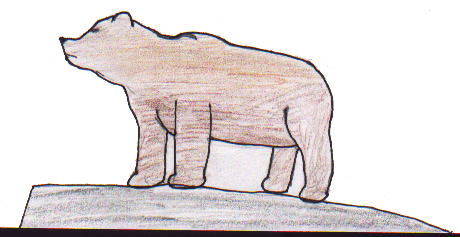This collection of student work is from
Frank Keim's classes. He has wanted to share these works for others
to use as an example of Culturally-based curriculum and documentation. These
documents have been OCR-scanned. These are available
for educational use only.
Brownies
HABITAT
The Brown bear has the widest range
of all bears in the world .It ranges much of the northern
hemisphere, both east and west. Although Brown bears are found in a
variety of areas, they prefer river valleys, mountain forests, and
open meadows.
BROWN BEAR'S
BODY
The Brownie's body is rather chunky
and has a lump on its back made of fat and muscle. The brown bear has
a wide heavy head with a "dish faced" appearance. It also has very
powerful jaws, and paws with very long claws.
HIBERNATION
In all parts of the Brown bear's
range, except in Turkey and Iran, the bear is in a den during the
winter season. At the start of the denning season, they might have 6
to 10 inches of fat under their fur. The most common kind of dens are
rock caves, or a hole dug under a large tree or into a snow drift.
Depending on the weather, bears will den from the middle of September
to November.
REPRODUCTION OF
A BROWN BEAR
Some Brown bears may live as much as
thirty years old. One female was reported to have cubs when she was
twenty- five years old in a zoo. Females don't usually breed until
they are at least five years old. The breeding season is in June or
July. The cubs are born in January or February. The usual size of a
litter is two, but four is not uncommon. When cubs are born they are
less than one pound, but when nursing they gain as much as
thirty-three percent of fat. When the cubs are grown up they may
weigh a thousand times more than their weight at birth.
By MATTHEW SHORTY

Christmastime Tales
Stories real and imaginary about Christmas, Slavik, and the New Year
Winter, 1996 |
Christmastime Tales II
Stories about Christmas, Slavik, and the New Year
Winter, 1998 |
Christmastime Tales III
Stories about Christmas, Slavik, and the New Year
Winter, 2000 |
| Summer Time Tails 1992 |
Summertime Tails II 1993 |
Summertime Tails III |
| Summertime Tails IV Fall, 1995 |
Summertime Tails V Fall, 1996 |
Summertime Tails VI Fall, 1997 |
| Summertime Tails VII Fall, 1999 |
Signs of the Times November 1996 |
Creative Stories From Creative Imaginations |
| Mustang Mind Manglers - Stories of the Far Out,
the Frightening and the Fantastic 1993 |
Yupik Gourmet - A Book of
Recipes |
|
| M&M Monthly |
|
|
| Happy Moose Hunting! September Edition 1997 |
Happy Easter! March/April 1998 |
Merry Christmas December Edition 1997 |
| Happy Valentine’s
Day! February Edition
1998 |
Happy Easter! March/April Edition 2000 |
Happy Thanksgiving Nov. Edition, 1997 |
| Happy Halloween October 1997 Edition |
Edible and Useful Plants of Scammon
Bay |
Edible Plants of Hooper Bay 1981 |
| The Flowers of Scammon Bay Alaska |
Poems of Hooper Bay |
Scammon Bay (Upward Bound Students) |
| Family Trees and the Buzzy Lord |
It takes a Village - A guide for parents May 1997 |
People in Our Community |
| Buildings and Personalities of
Marshall |
Marshall Village PROFILE |
Qigeckalleq Pellullermeng ‘A
Glimpse of the Past’ |
| Raven’s
Stories Spring 1995 |
Bird Stories from Scammon Bay |
The Sea Around Us |
| Ellamyua - The Great Weather - Stories about the
Weather Spring 1996 |
Moose Fire - Stories and Poems about Moose November,
1998 |
Bears Bees and Bald Eagles Winter 1992-1993 |
| Fish Fire and Water - Stories about fish, global warming
and the future November, 1997 |
Wolf Fire - Stories and Poems about Wolves |
Bear Fire - Stories and Poems about Bears Spring,
1992 |